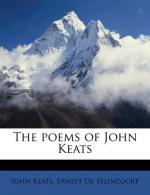|
This section contains 8,978 words (approx. 30 pages at 300 words per page) |

|
SOURCE: "Concrete and Abstract Imagery," in The Imagery of Keats and Shelley: A Comparative Study, Archon Books, 1949, pp. 184-240.
In the following excerpt, published originally in 1949, Fogle examines the characteristics of what many critics describe as the "concreteness" of Keats's imagery. Fogle demonstrates that Keats's technique of focusing his perceptions upon single objects results in the extraction of "the last drop of beauty and meaning" and also affects the metrical structure of the poetry.
I
Critics are generally agreed that the imagery of Keats is "concrete." Robert Bridges, for example, in comparing his "Sleep and Poetry" with Wordsworth's Tintern Abbey, points out "the extreme difference between Keats' objective treatment and Wordsworth's philosophising," citing to show the contrast the older poet's
The coarser pleasures of my boyish days
And their glad animal movements
over against Keats's
A pigeon tumbling in clear summer air;
A laughing schoolboy, without grief or...
|
This section contains 8,978 words (approx. 30 pages at 300 words per page) |

|


